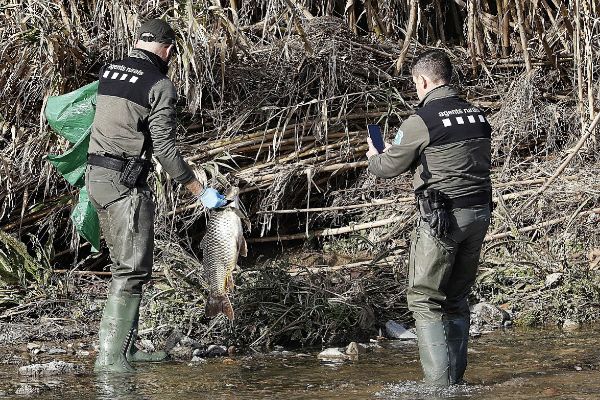- Species. Fauna peeks back to Besòs
The Generalitat imposed two penalties of 48,000 and 100,000 euros to the company Derpin, of Montornès del Vallès, for infractions in the storage of chemical waste. The sanctions did not prevent, with the fire declared on Tuesday in the ship, corrosive liquids flowed to the Besòs river, which caused an ecological disaster with dozens of dying fish and that has jeopardized the work to heal a flow that was declared highly contaminated . In the absence of the Prosecutor's Office investigating, the Government pays the thesis that the fluid was not due to an incidence in the factory, but that the solvents accumulated for recycling were mixed with the water with which the Firefighters stifled the fire and spilled on the channel, next to the accident. The mishap has reminded the spills that corrupted the Besòs in the 80s of the last century and has shown that they are not episodes of which a still brittle landscape is safe, which has revived after years of dedication.
“It cannot be that an industrial waste warehouse is next to a river that we had recovered,” says Albert Rodríguez, of the Mollet pel Futur environmental group. The Generalitat and the city councils of the basin have announced today that they will face the company if it is proven that they neglected, while they will value endorsing the cost of damages. While the waters are still being analyzed, they affirmed that the most serious effects on nature have been contained and speculated on strengthening controls to prevent accidents.
Rodriguez emphasizes that Derpin "is not the only" factory that carries dangerous material in the immediate vicinity of the Besòs: "It is full of aggregate factories. There are chemists in Montmeló, Montornès ... The Besòs is born where the Congost and the Mogent meet, which above are full of chemical industry ». He believes that "it should be planned to leave these natural spaces."
The Mollet platform - a neighboring city where the flames broke loose - and Ecologists in Action accuse administrations of sparing measures to prevent the risk that has materialized this week. «Emergency protocols have not worked. A lot of damage has been done to the environment, where there are many species, but also to people, with the air pollution produced ”, emphasizes Quim Pérez, water spokesman for Ecologists in Action.
Warnings
The entity warned more than 15 years ago that the Polytechnic University of Catalonia and the Catalan Institute of Oncology warned of possible damage to health by the level of volatile organic compounds that scattered companies near the basin, in the same environment where it has been triggered the incident: «We constantly suffer bad odors that come from solvents but, in case of an accident, multiply. Mollet, Montornès and Martorelles are in an area with quite dangerous industries, which treat flammable products, as has been proven, and harmful ».
«It cannot be that in a river so vulnerable and so fragile this can happen. We must ensure that it does not happen again ”, postulates Antoni Alarcón, director of the Barcelona Zoo and biologist in charge of directing the regeneration of the Besòs in the 90s,“ in adverse and industrial conditions ”, just a decade after, remember, will begin to stop that "more than a thousand companies" throw pollutants.
«The day after the discharge, we evaluated a section in Montcada and verified the smell of solvent. And that was about 10 kilometers from where it originated. We removed agonized fish, ”says Alarcón, who emphasizes that with the incident“ he has not returned 30 years ago, when it was a sewer, ”but he sees the river“ damaged, with a serious affectation ”. Alarcón advocates that the forced cleaning work of the Besòs be used to restrict the exotic species that have taken root, such as the Florida turtle or the American crab. "If we do not really recover the river, citizens will claim it, because it has been theirs," he predicts.
The Zoo has offered to collaborate in studies on wildlife damage. It is involved in monitoring programs for species such as the otter, of which at least four specimens have been sighted that accredit the improvement of the Besòs. It does so together with the Institute of Environmental Science and Technology of the UAB, which plans to take samples in the coming weeks to see if the river is recovering. «We are in a direct phase of the impact and very initial», diagnoses the researcher Sònia Sánchez, who points out that «the fragility of the river» has been evidenced and that the focus should be placed on «the measures that are necessary so that the repeat". He adds that "rivers are resilient systems, with resilience," as are animals, although "at different rates," to be examined.
According to the criteria of The Trust Project
Know moreAbuseThe Civil Guard rescues in terrible conditions seven hunting dogs from a Penáguila farm
Science They extract more than seven kilos of plastic, tissues and garbage from a dead deer in a Thai national park
Appointment Elsa Martín Olsen: from 'The jungle of celebrities' to Commissioner of Animal Welfare of Ayuso

